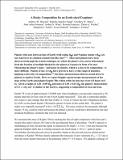| dc.contributor.author | Howard, Andrew W. | |
| dc.contributor.author | Marcy, Geoffrey W. | |
| dc.contributor.author | Johnson, John Asher | |
| dc.contributor.author | Isaacson, Howard | |
| dc.contributor.author | Fischer, Debra A. | |
| dc.contributor.author | Fulton, Benjamin J. | |
| dc.contributor.author | Sinukoff, Evan | |
| dc.contributor.author | Fortney, Jonathan J. | |
| dc.contributor.author | Sanchis Ojeda, Roberto | |
| dc.contributor.author | Winn, Joshua Nathan | |
| dc.date.accessioned | 2014-08-11T19:18:49Z | |
| dc.date.available | 2014-08-11T19:18:49Z | |
| dc.date.issued | 2013-10 | |
| dc.date.submitted | 2013-09 | |
| dc.identifier.issn | 0028-0836 | |
| dc.identifier.issn | 1476-4687 | |
| dc.identifier.uri | http://hdl.handle.net/1721.1/88682 | |
| dc.description.abstract | Planets with sizes between that of Earth (with radius R[subscript circle in cross]) and Neptune (about 4 R[subscript circle in cross]) are now known to be common around Sun-like stars. Most such planets have been discovered through the transit technique, by which the planet’s size can be determined from the fraction of starlight blocked by the planet as it passes in front of its star. Measuring the planet’s mass—and hence its density, which is a clue to its composition—is more difficult. Planets of size 2–4 R[subscript circle in cross] have proved to have a wide range of densities, implying a diversity of compositions, but these measurements did not extend to planets as small as Earth. Here we report Doppler spectroscopic measurements of the mass of the Earth-sized planet Kepler-78b, which orbits its host star every 8.5 hours (ref. 6). Given a radius of 1.20 ± 0.09 R[subscript circle in cross] and a mass of 1.69 ± 0.41 M[subscript circle in cross], the planet’s mean density of 5.3 ± 1.8 g cm[superscript −3] is similar to Earth’s, suggesting a composition of rock and iron. | en_US |
| dc.description.sponsorship | Kepler Participating Scientist Program | en_US |
| dc.language.iso | en_US | |
| dc.publisher | Nature Publishing Group | en_US |
| dc.relation.isversionof | http://dx.doi.org/10.1038/nature12767 | en_US |
| dc.rights | Creative Commons Attribution-Noncommercial-Share Alike | en_US |
| dc.rights.uri | http://creativecommons.org/licenses/by-nc-sa/4.0/ | en_US |
| dc.source | arXiv | en_US |
| dc.title | A rocky composition for an Earth-sized exoplanet | en_US |
| dc.type | Article | en_US |
| dc.identifier.citation | Howard, Andrew W., Roberto Sanchis-Ojeda, Geoffrey W. Marcy, John Asher Johnson, Joshua N. Winn, Howard Isaacson, Debra A. Fischer, Benjamin J. Fulton, Evan Sinukoff, and Jonathan J. Fortney. “A Rocky Composition for an Earth-Sized Exoplanet.” Nature 503, no. 7476 (October 30, 2013): 381–384. | en_US |
| dc.contributor.department | Massachusetts Institute of Technology. Department of Physics | en_US |
| dc.contributor.department | MIT Kavli Institute for Astrophysics and Space Research | en_US |
| dc.contributor.mitauthor | Sanchis Ojeda, Roberto | en_US |
| dc.contributor.mitauthor | Winn, Joshua Nathan | en_US |
| dc.relation.journal | Nature | en_US |
| dc.eprint.version | Author's final manuscript | en_US |
| dc.type.uri | http://purl.org/eprint/type/JournalArticle | en_US |
| eprint.status | http://purl.org/eprint/status/PeerReviewed | en_US |
| dspace.orderedauthors | Howard, Andrew W.; Sanchis-Ojeda, Roberto; Marcy, Geoffrey W.; Johnson, John Asher; Winn, Joshua N.; Isaacson, Howard; Fischer, Debra A.; Fulton, Benjamin J.; Sinukoff, Evan; Fortney, Jonathan J. | en_US |
| dc.identifier.orcid | https://orcid.org/0000-0002-4265-047X | |
| mit.license | OPEN_ACCESS_POLICY | en_US |
| mit.metadata.status | Complete | |
